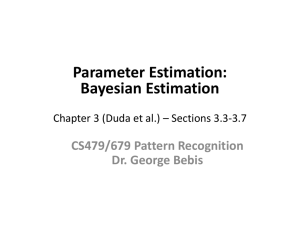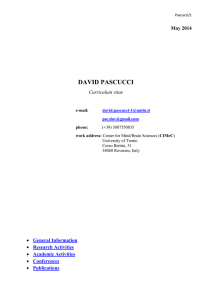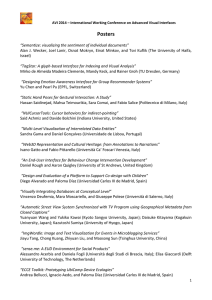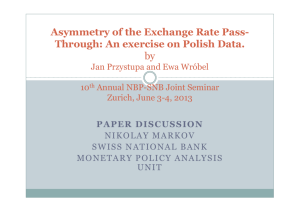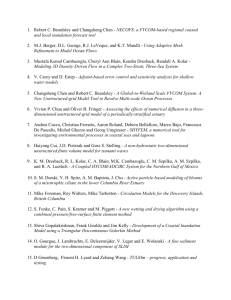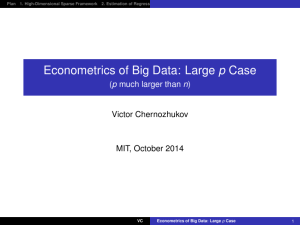Outline • Parameter estimation – Maximum likelihood estimation
advertisement
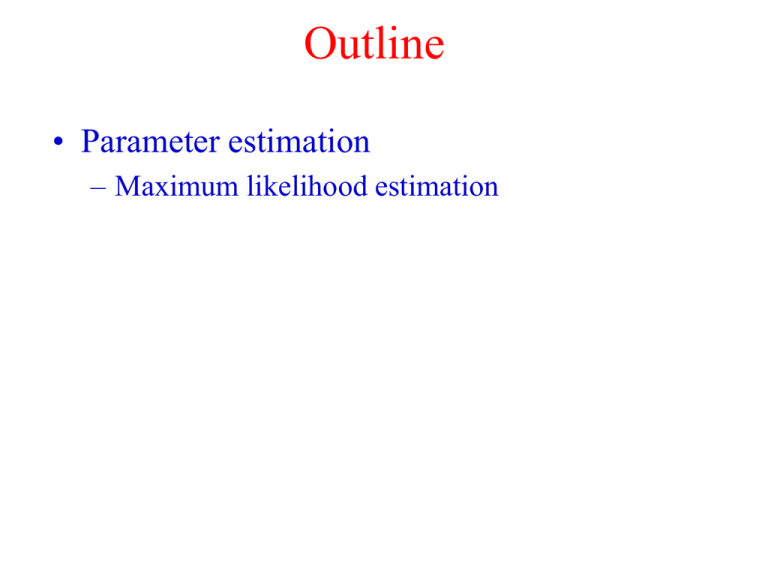
Outline
• Parameter estimation
– Maximum likelihood estimation
Bayes Decision Theory
• Assumptions
– Suppose that there are c categories
• {1, 2, ....., c}
– The prior probability and class conditional
density are known
– There are a possible actions
• {1, 2, ....., a}
– Loss function (i | j} describe the loss incurred
for taking action i when the state of nature is j
5/29/2016
Visual Perception Modeling
2
Bayes Decision Rule
• To minimize the overall risk, compute the
conditional risk and select the action for
which the conditional risk is minimum
c
R( i | x) ( i | j ) P( j | x)
j 1
– The resulting minimum overall risk is called the
Bayes risk, which is the best performance
5/29/2016
Visual Perception Modeling
3
Discriminant Functions for Normal Density
• Minimum error rate classification for normal
density
1
d
t 1
g i ( x) ( x i ) i ( x i ) ln( 2 )
2
2
1
ln(| i |) ln( P( i ))
2
• Three different cases
5/29/2016
Visual Perception Modeling
4
Parameter Estimation
• We could design an optimal classifier if we
knew the prior probabilities and the classconditional densities
– Unfortunately, in pattern recognition applications we
rarely have this kind of complete knowledge about
the probabilistic structure of the problem
• Training data
– Some vague, general knowledge about the problem
– A number of design samples
5/29/2016
Visual Perception Modeling
5
Parameter Estimation – cont.
• Two approaches
– Parameter estimation
• Estimate the parameters of the unknown probabilities
and probability densities
– Non-parametric procedures
• Multi-layer perceptrons and in general neural
networks
• Fisher linear discriminant function
• Work in the feature space directly
5/29/2016
Visual Perception Modeling
6
Parameter Estimation – cont.
• Parameter estimation
– Maximum-likelihood approach
• Parameters as quantities whose values are fixed but
unknown
• The best estimate of their value is the one that
maximizes the probability of obtaining the samples
– Bayesian learning
• Parameters are random variables with known prior
distribution
• Observations convert the prior into posteriori
5/29/2016
Visual Perception Modeling
7
Maximum-Likelihood Estimation
• Assumptions
– We separate a collection of samples according to class
• D1, D2, ....., Dc
– Samples in Dj are drawn independently according to
the probability p(x|j)
– We assume that p(x|j) has a known parametric form
and is uniquely determined by the value of a
parameter vector j
– To simplify further, we assume that samples in Di give
no information about j if i j
5/29/2016
Visual Perception Modeling
8
Maximum-Likelihood Estimation – cont.
• Suppose that D contains n samples
– x1, ....., xn
– By assumption that samples were drawn
independently, we have
n
p ( D | θ ) p ( xk | θ )
k 1
– The maximum-likelihood estimate of is the
value of * that maximizes p(D| )
5/29/2016
Visual Perception Modeling
9
Maximum-Likelihood Estimation – cont.
• Log-likelihood
l (θ ) ln( p ( D | θ ))
θ* arg max l (θ)
n
θ
l (θ) ln( p ( xk | θ))
k 1
n
θ l (θ) θ (ln( p ( xk | θ)) )
k 1
5/29/2016
Visual Perception Modeling
10
Maximum-Likelihood Estimation – cont.
• The maximum likelihood solution is
θl (θ) 0
– A solution * can be a true global maximum, a
local maximum, or a minimum, or an inflection
point of l()
• We need to check each solution individually
• Or calculate the second derivatives to identify the
global optimum
5/29/2016
Visual Perception Modeling
11
Maximum-Likelihood Estimation – cont.
• Gaussian case - Unknown
1
ln p ( xk | ) ln[( 2 ) d | |]
2
1
( xk )T 1 ( xk )
2
n
̂
1
5/29/2016
x
k 1
k
n
Visual Perception Modeling
12
Maximum-Likelihood Estimation – cont.
• Gaussian case - Unknown and
– Univariate case
1
1
ln p ( xk | θ ) ln 22
( xk 1 ) 2
2
2 2
1
( xk 1 )
2
θl (θ)
2
1 ( xk 1 )
2 2
2 22
5/29/2016
Visual Perception Modeling
13
Maximum-Likelihood Estimation – cont.
• Gaussian case - Unknown and continued
n k 1
̂ xk
1 n
ˆ 2
5/29/2016
n k 1
( xk ˆ ) 2
1 n
Visual Perception Modeling
14
Maximum-Likelihood Estimation – cont.
• Bias
– For a large number of samples,
n k 1
n 1
( xk
2 2
ˆ )2
1 n
n
5/29/2016
Visual Perception Modeling
15

